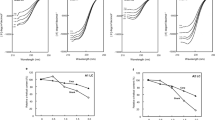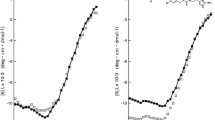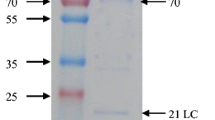Abstract
Myosin rod regions prepared from carp Cyprinus carpio dorsal muscle and scallop Pecten yessoensis striated adductor muscle were non-enzymatically reacted with glucose (glycation), and the changes in the filament-forming ability and the size distribution of the rod filaments during glycation were examined to discuss the molecular mechanism of the water solubilization of myosin molecules under physiological conditions. Both myosin rods became solubilized in 0.1 M NaCl (pH 7.5), and their filament-forming ability was weakened with the progress of glycation. The size of the insoluble filaments of the myosin rods was diminished with an increase in the solubility under physiological conditions, and glycated myosin rods finally existed as monomers in 0.1 M NaCl (pH 7.5). These results supported the hypothesis that the water solubilization of myosin by glycation was caused by the loss of the filament-forming ability of myosin molecules. Water solubilization seemed to occur through the same molecular mechanism regardless of the species, whereas the scallop myosin rods required a much larger number of lysine residues reacted with glucose to collapse the insoluble filaments, in contrast to the carp myosin rods.
Similar content being viewed by others
References
Nagaraj RH, Sell DR, Prabhakaram M, Ortwerth BJ, Monnier VM. High correlation between pentosidine protein corsslinks and pigmentation implicates ascorbate oxidation in human lens senescence and cataractogenesis. Proc. Natl Acad. Sci. USA 1991; 88: 10257–10261.
Day JF, Thornburg RW, Thorpe SR, Baynes JW. Nonenzymatic glucosylation of rat albumin. Studies in vitro and in vivo. J. Biol. Chem. 1979; 254: 9394–9400.
Hadley JC, Meek KM, Malik NS. Glycation changes the charge distribution of type I collagen fibrils. Glycoconj. J. 1998; 15: 835–840.
Lambotte O, Cacoub P, Costedoat N, Le Moel G, Amoura Z, Piette JC. High ferritin and low glycosylated ferritin may also be a marker of excessive macrophage activation. J. Rheumatol. 2003; 30: 1027–1028.
Wang XY, Bucala R, Milne R. Epitopes close to the apolip oprotein B low density lipoprotein receptor-binding site are modified by advanced glycation end products. Proc. Natl Acad. Sci. USA 1998; 95: 7643–7647.
Weed AG, Pope B. Studies on the chymotryptic digestion of myosin. J. Mol. Biol. 1977; 111: 129–157.
Huxley HE. Electron microscope studies on the structure of natural and synthetic protein filaments from striated muscle. J. Mol. Biol. 1963; 7: 281–308.
Watanabe H, Ogasawara M, Suzuki N, Nishizawa N, Ambo K. Glycation of myofibrillar protein in aged rats and mice. Biosci. Biotechnol. Biochem. 1992; 56: 1109–1112.
Syrovy I, Hodny Z. Non-enzymatic glycosilation of myosin: effect of diabetes and aging. Gen. Physiol. Biophys. 1992; 11: 301–307.
Syrovy I, Hodny Z. In vitro non-enzymatic glycosylation of myofibrillar proteins. Int. J. Biochem. 1993; 25: 941–946.
Ramamurthy B, Hook P, Jones AD, larsson L. Changes in myosin structure and function in response to glycation. FASEB J. 2001; 15: 2515–2422.
Saeki H, Inoue K. Improved solubility of carp myofibrillar proteins in low ionic strength medium by glycosylation. J. Agric. Food Chem. 1997; 45: 3419–3422.
Sato R, Sawabe T, Kishimura H, Hayashi K, Saeki H. Preparation of neoglycoprotein from carp myofibrillar protein and alginate oligosaccharide: improved solubility in low ionic strength medium. J. Agric. Food Chem. 2000; 48: 17–22.
Tanabe M, Saeki H. Effect of Maillard reaction with glucose and ribose on solubility at low ionic strength and filament-forming ability of fish myosin. J. Agric. Food Chem. 2001; 49: 3403–3407.
Katayama S, Haga Y, Saeki H. Loss of filament-forming ability of myosin by non-enzymatic glycosylation and its molecular mechanism. FEBS Lett. 2004; 575: 9–13.
Kato S, Konno K. Filament-forming domain of carp dorsal myosin rod. J. Biochem. 1993; 113: 43–47.
Gornall AG, Bardwill CJ, David MM. Determination of serum proteins by means of the biuret reaction. J. Biol. Chem. 1949; 177: 751–766.
Laemmli UK. Cleavage of structural proteins during the assembly of the head of bacteriophage T4. Nature 1970; 227: 680–685.
Medina-Hernandez MJ, Guarcia-Alvarez-Coque MC. Available lysine in protein, assay using o-phthalaldehyde/Nacetyl-L-cysteine spectrophotometric method. J. Food Sci. 1992; 57: 503–505.
Perrie WT, Perry SV. An electrophoretic study of the low molecular weight components of myosin. Biochem. J. 1970; 119: 31–38.
Itzhaki RF, Gill DM. A micro-biuret method for estimating proteins. Anal. Biochem. 1964; 9: 401–410.
Matsuura M, Konno K, Arai K. Thick filaments of fish myosin and its actin activated Mg-ATPase. Comp. Biochem. Physiol. 1988; 90B: 803–808.
McLachlan AD, Karn J. Periodic charge distributions in the myosin rod amino acid sequence match cross-bridge spacings in muscle. Nature 1982; 299: 226–231.
Saeki H, Tanabe M. Change in solubility of carp myofibrillar protein by modifying lysine residue with ribose. Fish. Sci. 1999; 65: 967–968.
Sato R, Katayama S, Sawabe T, Saeki H. Stability and emulsion-forming ability of water-soluble fish myofibrillar protein prepared by conjugation with alginate oligosaccharide. J. Agric. Food Chem. 2003; 51: 4376–4381.
Kato S, Konno K. Filament formation of carboxyl- and amino-group-modified carp myosin rod. Fish. Sci. 2000; 66: 124–129.
Saeki H. Japan Unexamined Patent Publication, P2003-169634. 2003.
Author information
Authors and Affiliations
Corresponding author
Additional information
An erratum to this article is available at http://dx.doi.org/10.1111/j.1444-2906.2007.01424.x.
Rights and permissions
About this article
Cite this article
Katayama, S., Saeki, H. Water solubilization of glycated carp and scallop myosin rods, and their soluble state under physiological conditions. Fish Sci 73, 446–452 (2007). https://doi.org/10.1111/j.1444-2906.2007.01353.x
Received:
Accepted:
Issue Date:
DOI: https://doi.org/10.1111/j.1444-2906.2007.01353.x




